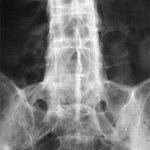A hallmark feature of ankylosing spondylitis (AS) and other spondylarthropathies is the involvement of the axial skeleton, leading to syndesmophyte formation and eventual fusion of the spine. This aggressive bone formation is paradoxically linked to profound osteoporosis, which makes these patients particularly vulnerable to fragility fracture. Interestingly, bone mineral density scores often improve following treatment with tumor necrosis factor (TNF)–blocking agents; however the role of TNF-α in bone remodeling is not fully understood in AS.
A study by Layh-Schmitt and colleagues, published in Arthritis & Rheumatism, reports the increased sensitivity of human-HLA-B27 transgenic rat bone marrow monocytes to TNF-α stimulation and osteoclast differentiation, compared to wild-type or human-HLA B7 transgenic rat controls.1 The increased expression and production of active interleukin (IL) 1α was found to drive this process, and blockade of IL-1α was sufficient to inhibit osteoclast development.
Based on results from their prior work, these researchers investigated the role of HLA-B27 in inducing endoplasmic reticulum (ER) stress and activating the unfolded protein response (UPR) in cultured monocytes. Interestingly, they found increased expression of binding immunoglobulin protein (BiP) and activated splice variants of x-box binding protein 1 (XBP1) after stimulation with TNF-α, with increased coprecipitation and localization of HLA-B27 and BiP, supporting their hypothesis of increased ER stress in this model.
Curiously, the HLA-B27 allele, known for its strong genetic association with AS, is reported to have a tendency to misfold or form homodimers. In experimental animal models, increased HLA-B27 expression and resultant misfolding has been implicated in ER stress and the activation of UPR. This work offers a novel insight into the role of HLA-B27 in support of an antigen-independent pathway resulting in the development of spondylitis.
Dr. O’Brien is a rheumatology fellow at Brigham and Women’s Hospital in Boston.
Reference



